What Secondhand Jewelry Means to 7 Different Women
#FashionCrisis is a series that kicks off Teen Vogue’s commitment to educating our readers about sustainability and fashion. We chat with experts, influencers, designers, beauty and fashion brands about what it really means to be sustainable in 2020. In this story, we chat with seven women about how their family jewels play a bigger role in their approach to conscious consumerism.
Secondhand shopping helped define the past decade, and there’s no sign of stopping this conscious-shopping movement. Now more than ever, young adults care about the impact of their shopping habits and are gravitating toward companies that share the same level of concern and awareness. When you consider how many liters of water it takes to make a single T-shirt, it’s no wonder thrifting is overtaking fast fashion.
Social media also plays a big role in this consumer shift. Posting vintage finds on IG is one way to showcase a unique style. Just peep the Kardashian klan’s access to designer archives — thrifting and vintage shopping have become the talk in every caption. And as the desire to score vintage finds has increased, so has the number of curated vintage boutiques that live solely on Instagram.
For others still, the love of clothing and jewelry from way back when starts at home. Secondhand items come from the legacy of past generations — memories made tangible as they are resurrected through their new wearer. Whether it’s a fur coat, a gold watch, or a pair of kitten heels, they’re family jewels.
We asked women from across the country and beyond the ponds to share with us their literal family jewels, and how these pieces of jewelry play a large role in their approach to conscious consumerism. Their responses might even inspire you to go shopping in your family’s jewel box or invest in pieces yourself to pass on down the road.
Minne Atairu, Artist and UX Designer, @usominne

Tell us the story of your family jewel.
Most Nigerian moms have a special part of the closet called the “bottom box.” My mom’s bottom box consists of items that she inherited from my grandma, who was a tailor and empowered women in her community through a tailoring program. So the items in my mom’s bottom box are pieces from my grandma’s collection and my mom’s pieces that she has acquired over time. When my mom visited last year, I requested this pin from her bottom-box because I have fallen in love with decorating my oversized blazers with pins. The necklace is also from my mom’s collection, probably from the late ’90s.
Tell us about your relationship with secondhand items.
I’ve learned to shop less, and this has made me discover multiple ways of styling pieces I already own. And these days, I find that I’m more interested in fully knowing who benefits from my purchases — even if I’m purchasing items from a second hand/vintage store. So, I make it a point to shop from stores where I have a relationship with the owners. They are women-owned businesses, I know my money is going to support the business, to support the family, to ensure the women are financially independent.
Liz Coulbourn, Junior Designer at Teen Vogue, @lizcoulbourn
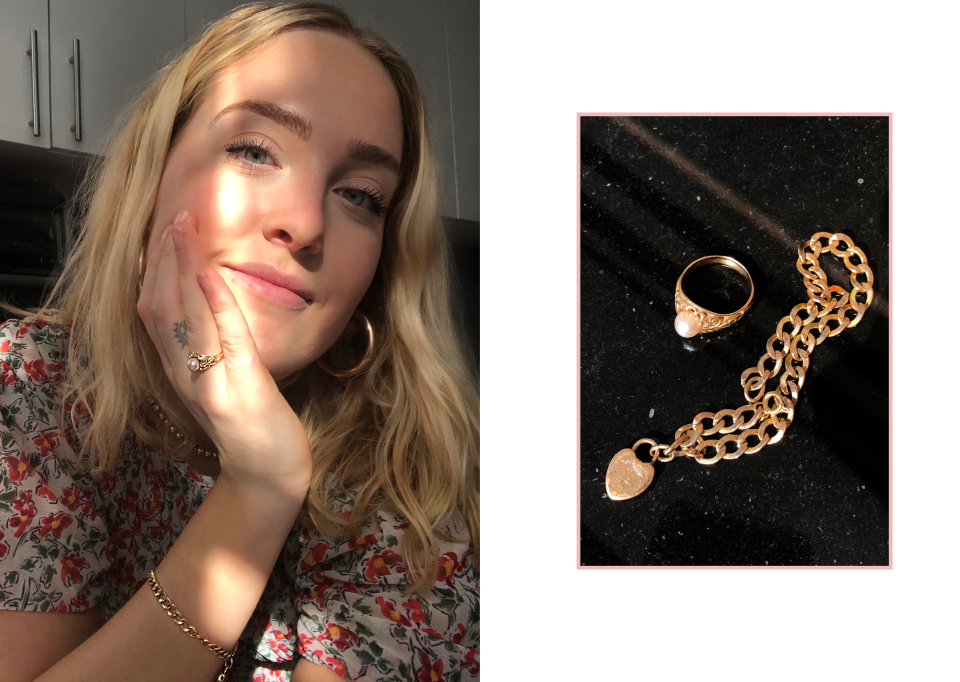
Tell us the story of your family jewel.
My grandmother was an antique dealer, living around the world collecting beautiful pieces, always with elaborate and detailed stories tied to them. She taught me to appreciate things like this — beautiful jewelry with a beautiful, exciting past. I have a large collection of jewelry from her, but these pieces she gave me tend to always stay on me. The gold pearl ring was given to me on my 21st birthday and hasn’t been taken off since. The gold charm bracelet was hers as a baby and has her initials delicately engraved on the locket. My grandmother passed away about a year ago, and having these items on always keeps a part of her adventurous and strong spirit with me wherever I am.
Tell us about your relationship with secondhand items.
From an early age, I was taught to appreciate the importance of vintage and thrifted pieces; it not only saves money and is better for the environment, but it always feels a bit more special and individualized. It’s like a treasure hunt. There is always something more exciting about finding a thing you love when it’s one of a kind.
My approach has always been buying secondhand and recycling my own clothing. Shopping secondhand, vintage, and thrifted is great not only when it comes to clothes, but also when looking for furniture and things for my apartment. Since living in New York, I can’t fit half the clothes I wish to in my apartment, so I try and donate or sell clothes to give them another life.
Jessica Manning, Singer and Vintage Shop Owner, @jessica_manning
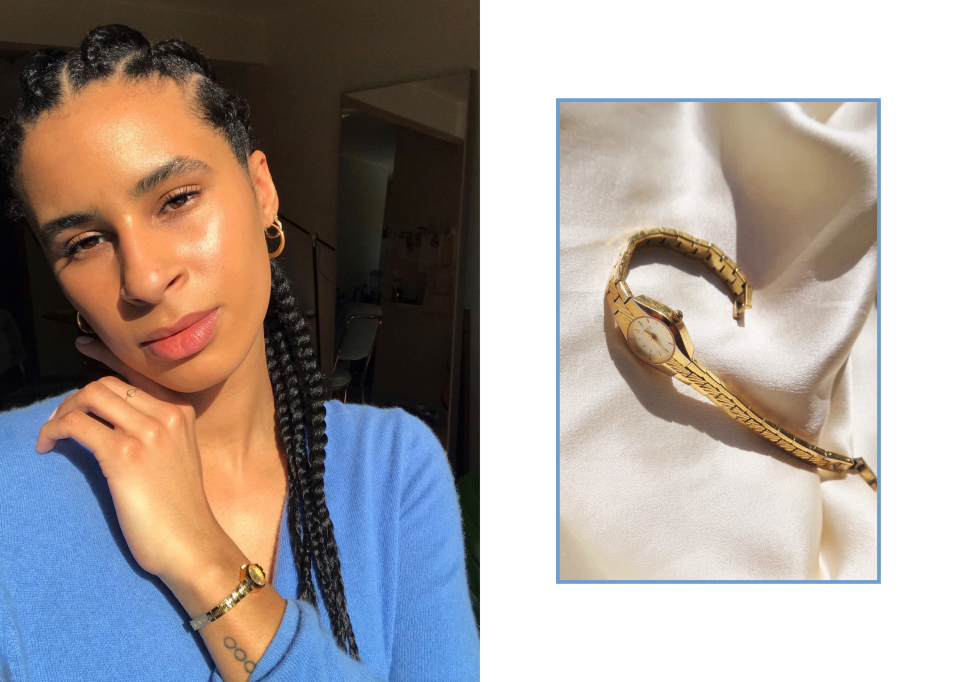
Tell us the story of your family jewel.
This dainty gold watch was given to me after my grandmother passed away many years ago. I come from a large family on my mother’s side, so when my grandparents passed away each person was able to select a few items that belonged to them. I, of course, gravitated to my grandmother’s jewelry collection. This beautiful little watch caught my eye immediately, and I was amazed that it fit me perfectly. A little piece of her that almost felt like it was meant for me.
Tell us about your relationship with secondhand items.
I’ve always had an interest in secondhand items whether they be thrifted or vintage. Thanks to my mom, who has always been very creative and resourceful, she instilled that love in me early on. Shopping secondhand began as a way to save money but quickly grew into a deep love for finding one-of-a-kind pieces and imagining the many lives they’d lived before us. By the time I chose this watch from my grandmother’s collection, I already had such a rooted appreciation for secondhand pieces and I think that made this item all the more special to me.
I’d say that about half of my closet is thrifted or vintage and the rest is mostly made up of modern sustainable brands. Hunting for vintage pieces has become such a love of mine, and quite honestly, even therapeutic. About six months ago I launched a little vintage shop of my own called Mae Vintage. Mae is the middle name I share with both of my grandmothers, who have now both passed on but who left me with so many beautiful pieces to remember them by. This felt like the perfect way to honor them.
Sara Negrón, Artist and Content Creator, @miniti
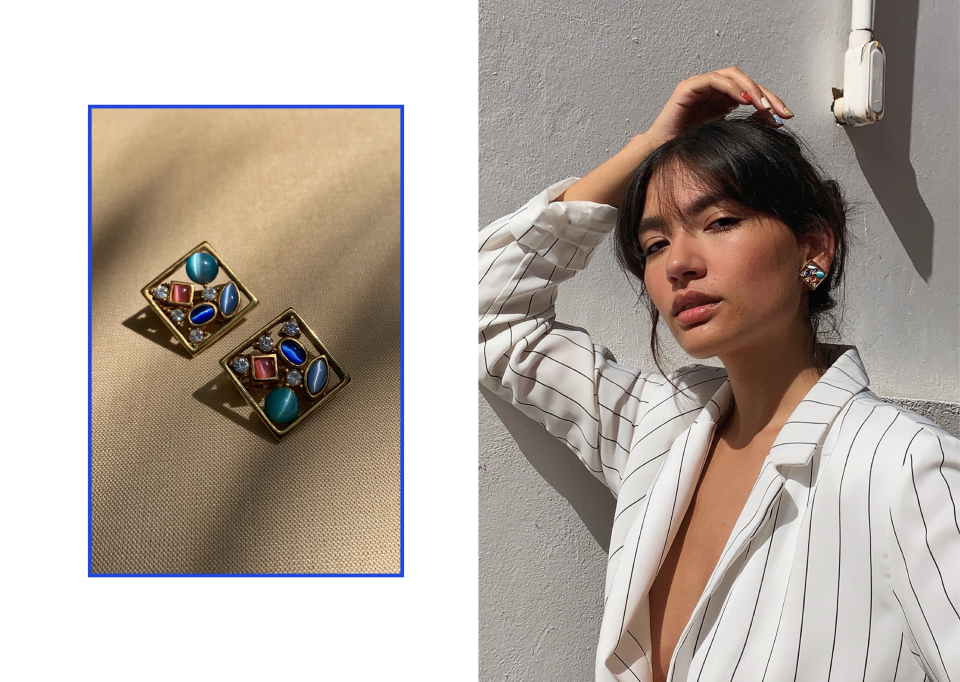
Tell us the story of your family jewel.
The source for all my family jewels is my mom, Elsa. Through the different stages of my life, I’ve shifted my interests, going back and forth with what I’d borrow from her jewelry box: As a kid, I was drawn to gold bangles and long, pearl necklaces, while in my teens I opted for chunky ’80s earrings. Now, in my early 20s, I borrow from her array of options whenever I need a statement piece, like these jewel-toned clip-ons. She wants me to own my favorite items from her collection, but I find it more meaningful to borrow them. I’ll always consider them hers. It’s as if I’m adding a bit of her style, which is very different from mine, to come along with me for the day. If I’d own them, I feel it would lose the story and weight they carry and start rewriting it as my own.
Tell us about your relationship with secondhand items.
It’s tricky to have a stable approach to sustainable shopping. In Puerto Rico, where I’m from and currently reside, there are very few secondhand shops (at least around the metro area) that are reasonably priced. I don’t always have the budget to take a lot of items to a tailor and I have limited sewing skills, so I rarely purchase clothing in these shops, aside from the occasional blazer, and stick to accessories. There are a lot of boutiques selling vintage, and even some that describe themselves as secondhand, but the pricing is very high for the quality. I’m only stating that shopping secondhand on the island is not always an accessible option.
Aside from these stores, my knowledge is we only have the Salvation Army as a “big” thrift store. There’s no Goodwill or other widely known nonprofits aimed at a similar market. However, the Salvation Army has a history of being anti-LGBTQ+, and as part of the community, I refuse to support it. Another way I try to be sustainable with fashion is doing closet exchanges with my friends. I’ve also seen some of them selling a few of their clothing items through Instagram Stories or apps like Depop, which I’ve yet to take part in but admire them for it. Although I agree and understand the importance of sustainable shopping and fashion, the reality is that it’s difficult — if not near-impossible — to be 100% sustainable if you don’t have a higher income than, say, the average young adult. Efforts are always made, but unfortunately, I still have to rely on fast fashion most of the time.
Imani Aldridge, Content Creator, @imanimodus
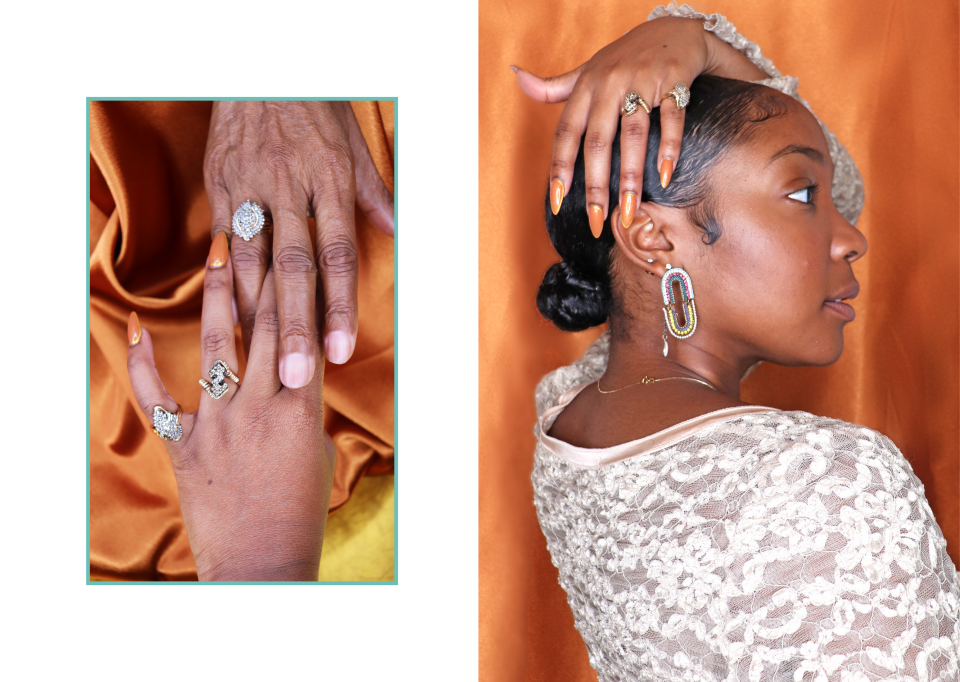
Tell us the story of your family jewel.
My grandmother passed her gold and diamond rings down to me. I have this vivid memory of her wearing her long red nails (she doesn’t anymore) and her rings stacked on each finger. I’ve always admired this image of black women as it’s one commonly seen in my community; it’s an expression of creativity and self-worth.
Tell us about your relationship with secondhand items.
My interest in secondhand and vintage shopping has been with me since childhood; my mom, dad, and grandmother are all thrifters. I used to be embarrassed by it, honestly. The appreciation for it came much later when I realized the gems that thrift, vintage, and consignment shops have. I’m a believer in buying items that are quality and that I love. When it comes to sustainable shopping, I’ll always be a thrifter.
Alexandra Diaz, Law Student, @alexandra.banessa
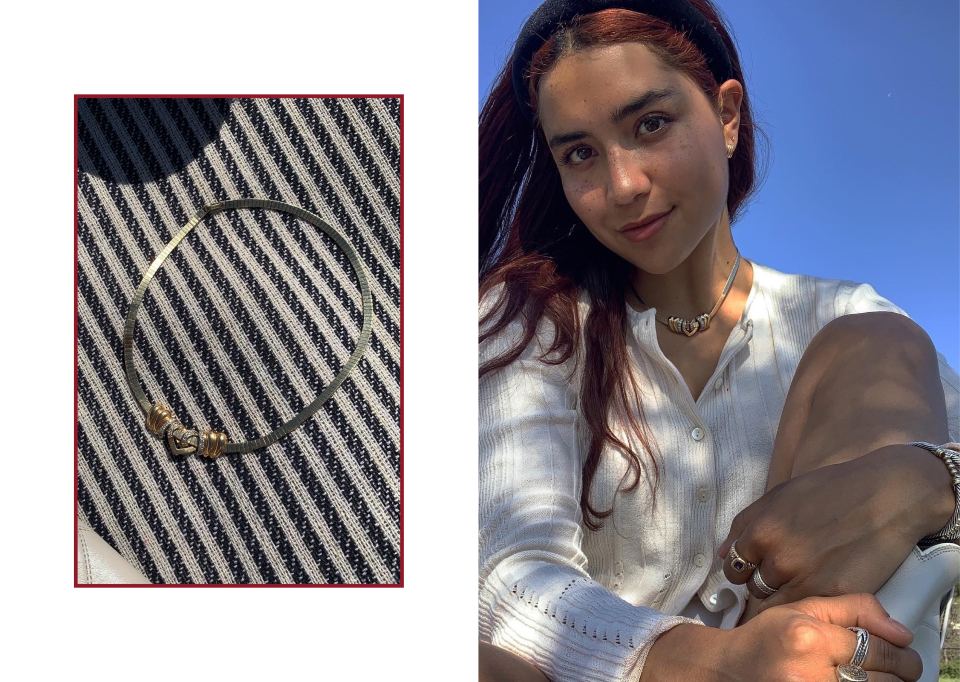
Tell us the story of your family jewel.
This piece was given to me by my mom. It’s a gold choker that my dad had given her when they were younger. My mom customized the piece with three little charms that are removable, which makes it extremely versatile. Growing up I would always scavenge through her jewelry box because she always had the most amazing collection of chunky gold jewelry, so over time she just started picking out pieces to give me. I received this piece from her this summer, right before starting my first year of law school. I love the ’80s aesthetic of this necklace and what it does to an outfit, but what I really love is the story that it tells me. Though my parents are now divorced, when I wear it, I am reminded of both them in the best way and I think of each of us a little charm, bopping around my neck. Cheesy, I know, but I can’t help that I am a hopeless romantic. This piece truly is so special to me and I hope to pass it down to my daughter one day.
Tell us about your relationship with secondhand items.
My love for shopping vintage started long before I received this piece. When I was younger, I gleaned a lot of inspiration from my grandmother, who was the most elegant and chic woman I have ever met, to do this day. I often found that to emulate her, I had to go out of my way to find very special and unique pieces — pieces you could not typically find in a department store. The inspiration from my grandmother coupled with a plethora of flea markets, swap meets, and vintage stores at my disposal, allowed me to become well-versed in the ways of thrifting by the time I was in middle school. Since then, vintage shopping has been my preferred method of shopping because it has always managed to speak to my ever-evolving and dynamic style, and for that, I will always love it.
Birgit Fischer, Owner of Onimos Store, @birgit.anja

Tell us the story of your family jewel.
I inherited my pearl necklaces from my mother. She gave them to me for my wedding day so I could wear “something old“ and honor my family heritage. It means a lot to me as the pearls remind me of my family, as well as of my wonderful wedding day.
Tell us about your relationship with secondhand items.
I have had my own vintage clothing business for quite some time before my mother gave me the pearls, but my affection for vintage is definitely connected to her. [Now] my whole days revolve around sustainable shopping. It’s an absolute dream come true to run my own vintage clothing company with two stores in two countries, and we‘re right now about to open a third store in London.
Let us slide into your DMs. Sign up for the Teen Vogue daily email.
Want more from Teen Vogue? Check this out: Fast Fashion Is a Feminist Issue
Originally Appeared on Teen Vogue

